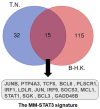Biological Hallmarks and Emerging Strategies to Target STAT3 Signaling in Multiple Myeloma
- PMID: 35326392
- PMCID: PMC8946161
- DOI: 10.3390/cells11060941
Biological Hallmarks and Emerging Strategies to Target STAT3 Signaling in Multiple Myeloma
Abstract
Multiple myeloma (MM) is the second most common hematological malignancy, characterized by an abnormal accumulation of plasma cells in the bone marrow. Signal transducer and activator of transcription 3 (STAT3) is a cytoplasmic transcription factor that modulates the transcription of multiple genes to regulate various principal biological functions, for example, cell proliferation and survival, stemness, inflammation and immune responses. Aberrant STAT3 activation has been identified as a key driver of tumorigenesis in many types of cancers, including MM. Herein, we summarize the current evidence for the role of STAT3 in affecting cancer hallmark traits by: (1) sustaining MM cell survival and proliferation, (2) regulating tumor microenvironment, (3) inducing immunosuppression. We also provide an update of different strategies for targeting STAT3 in MM with special emphasis on JAK inhibitors that are currently undergoing clinical trials. Finally, we discuss the challenges and future direction of understanding STAT3 signaling in MM biology and the clinical development of STAT3 inhibitors.
Keywords: JAK inhibitor; hallmarks of cancer; multiple myeloma; signal transducer and activator of transcription 3 (STAT3); targeted therapy.
Conflict of interest statement
The authors declare no conflict of interest.
Figures


Similar articles
-
Signal transducer and activator of transcription 3 as a therapeutic target for cancer and the tumor microenvironment.Arch Pharm Res. 2016 Aug;39(8):1085-99. doi: 10.1007/s12272-016-0795-8. Epub 2016 Aug 11. Arch Pharm Res. 2016. PMID: 27515050 Review.
-
Inhibiting aberrant signal transducer and activator of transcription protein activation with tetrapodal, small molecule Src homology 2 domain binders: promising agents against multiple myeloma.J Med Chem. 2013 Sep 26;56(18):7190-200. doi: 10.1021/jm3017255. Epub 2013 Sep 13. J Med Chem. 2013. PMID: 23968501
-
As4S4 Exhibits Good Killing Effect on Multiple Myeloma Cells Via Repressing SOCS1 Methylation-Mediated JAK2/STAT3 Signaling Pathway.Technol Cancer Res Treat. 2019 Jan-Dec;18:1533033819896806. doi: 10.1177/1533033819896806. Technol Cancer Res Treat. 2019. PMID: 31868118 Free PMC article.
-
The JAK/STAT3 axis: A comprehensive drug target for solid malignancies.Semin Cancer Biol. 2017 Aug;45:13-22. doi: 10.1016/j.semcancer.2017.06.001. Epub 2017 Jun 21. Semin Cancer Biol. 2017. PMID: 28647610 Review.
-
Unraveling the complexity of STAT3 in cancer: molecular understanding and drug discovery.J Exp Clin Cancer Res. 2024 Jan 20;43(1):23. doi: 10.1186/s13046-024-02949-5. J Exp Clin Cancer Res. 2024. PMID: 38245798 Free PMC article. Review.
Cited by
-
Multiple myeloma: signaling pathways and targeted therapy.Mol Biomed. 2024 Jul 4;5(1):25. doi: 10.1186/s43556-024-00188-w. Mol Biomed. 2024. PMID: 38961036 Free PMC article. Review.
-
Biological research on the occurrence and development of multiple myeloma and its treatment.Immun Inflamm Dis. 2023 May;11(5):e850. doi: 10.1002/iid3.850. Immun Inflamm Dis. 2023. PMID: 37249283 Free PMC article.
-
Bruceine B Displays Potent Antimyeloma Activity by Inducing the Degradation of the Transcription Factor c-Maf.ACS Pharmacol Transl Sci. 2023 Dec 5;7(1):176-185. doi: 10.1021/acsptsci.3c00222. eCollection 2024 Jan 12. ACS Pharmacol Transl Sci. 2023. PMID: 38230274 Free PMC article.
-
Upregulated Expression of ERBB2/HER2 in Multiple Myeloma as a Predictor of Poor Survival Outcomes.Int J Mol Sci. 2023 Jun 9;24(12):9943. doi: 10.3390/ijms24129943. Int J Mol Sci. 2023. PMID: 37373090 Free PMC article.
-
Overexpression of miR-125a-5p Inhibits Hepatocyte Proliferation through the STAT3 Regulation In Vivo and In Vitro.Int J Mol Sci. 2022 Aug 4;23(15):8661. doi: 10.3390/ijms23158661. Int J Mol Sci. 2022. PMID: 35955794 Free PMC article.
References
Publication types
MeSH terms
Substances
LinkOut - more resources
Full Text Sources
Medical
Miscellaneous

